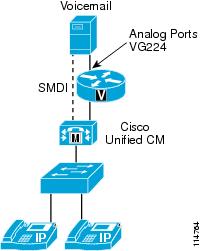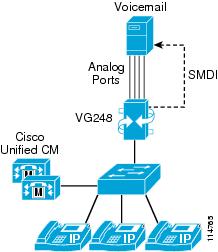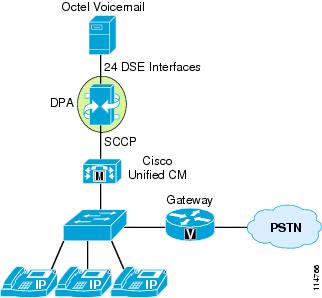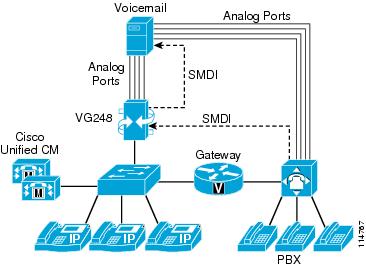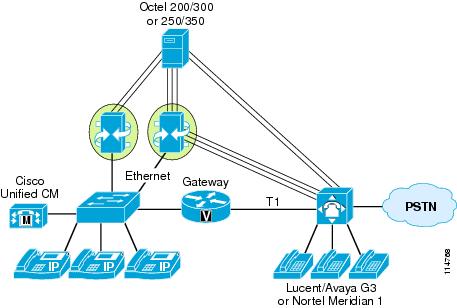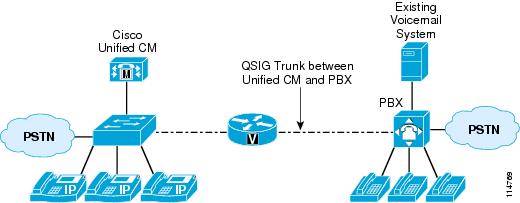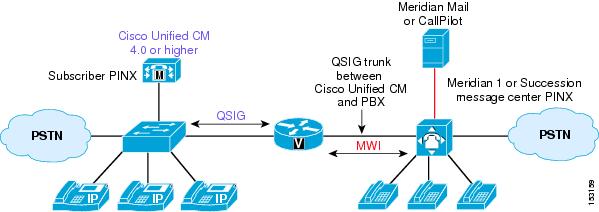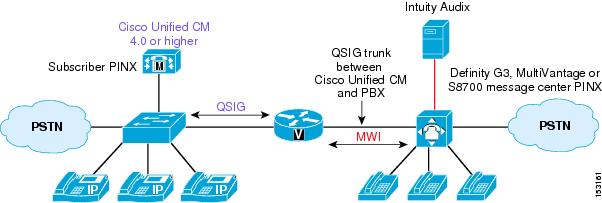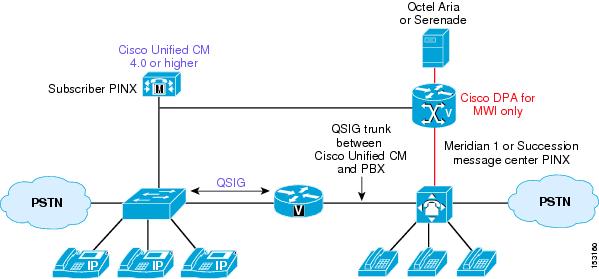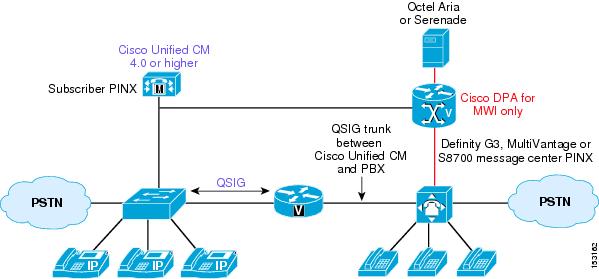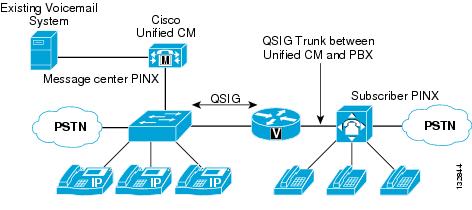

-
Cisco Unified Communications SRND Based on Cisco Unified Communications Manager 5.x
-
Preface
-
Introduction
-
IP Telephony Deployment Models
-
Network Infrastructure
-
Gateways
-
Cisco Unified Communications Manager Trunks
-
Media Resources
-
Music on Hold
-
Call Processing
-
Call Admission Control
-
Dial Plan
-
Emergency Services
-
Third-Party Voicemail Design
-
Cisco Unity
-
Cisco Unified MeetingPlace Integration
-
Cisco Unified MeetingPlace Express
-
IP Video Telephony
-
LDAP Directory Integration
-
IP Telephony Migration Options
-
Voice Security
-
IP Telephony Endpoints
-
Cisco Unified Presence
-
Cisco Unified Communications Manager Applications
-
Cisco Mobility Applications
-
Recommended Hardware and Software Combinations
-
Glossary
-
Index
-
Table Of Contents
Considerations When Using FXS Ports
Positive Disconnect Supervision
Summary of Third-Party Voicemail Integration
Third-Party Voicemail Design
This chapter discusses various options for deploying third-party voicemail systems with Cisco Unified Communications Manager (Unified CM).
Note
This chapter does not discuss how to size a voicemail system for ports and/or storage. For this type of information, contact your voicemail vendor, who should be better able to discuss the individual requirements of their own system based upon specific traffic patterns.
There are many voicemail vendors, and it is not uncommon for customers to want to continue to use an existing voicemail system when deploying Unified CM. With this requirement in mind, Cisco provides support for the industry standard voicemail protocol known as Simplified Message Desk Interface (SMDI). SMDI is a serial protocol that provides all the necessary call information required for a voicemail system to answer calls appropriately.
There are also other options for integrating Unified CM to voicemail systems, such as digital set emulation, Microsoft TAPI, QSIG, and so forth. Each method has its own pros and cons, and the method you employ will largely depend on how your voicemail system is integrated to your current PBX.
This section covers the following aspects of integrating third-party voicemail systems with Unified CM:
•
SMDI
•
Positive Disconnect Supervision
•
Summary of Third-Party Voicemail Integration
SMDI
Unified CM supports use of SMDI through either of the following methods:
Cisco Messaging Interface
The Cisco Messaging Interface (CMI) is a Unified CM service that should be run only on the publisher server. This service intercepts calls destined for voicemail and generates appropriate SMDI messages, which are then delivered to one of the server's Component Object Model (COM) ports. The CMI service is compatible with any MGCP gateway that supports analog FXS ports or T1 CAS E&M; however, the WS-X6624 and VG224 modules are two of only three gateways that support positive disconnect supervision (see Positive Disconnect Supervision) and are therefore the only gateways currently recommended for use with the CMI service.
Note
The Cisco WS-X6624 is at End of Sale (EoS).
Figure 12-1 illustrates the use of SMDI through the CMI service in Unified CM.
Figure 12-1 SMDI via Unified CM
Through the CMI, Unified CM supports integration with virtually any voicemail system that can provide SMDI with analog FXS ports, including (but not limited to) the following:
•
Octel 100, 200/300, and 250/350
•
Intuity Audix
•
Siemens PhoneMail
•
Centigram/BayPoint (OnePoint and NuPoint Messenger)
•
Lyrix ECS
•
IBM Message Center
Cisco VG248
The Cisco VG248 is an SCCP gateway that supports 48 analog FXS ports and generates SMDI locally (that is, it runs independent of the CMI service). As with the WS-X6624 and VG224 modules, the VG248 also supports positive disconnect supervision.
Figure 12-2 illustrates the use of SMDI with the VG248.
Figure 12-2 SMDI via the VG248
Voicemail integration through the VG248 provides the following features and advantages:
•
Multiple SMDI links per Unified CM
•
SMDI failover capability
•
Independence from the location of the voicemail system
The VG248 is also capable of supporting two other serial protocols that are sometimes used for voicemail integration: NEC Message Center Interface (MCI) and Ericsson MD110 proprietary protocol.
Considerations When Using FXS Ports
If your voicemail system is equipped with analog FXS ports, use the following Cisco gateways to integrate with the voicemail system:
•
WS-X6624
Use this module when there is a slot available for it in the Catalyst 6500 chassis.
•
VG224
Use this gateway when there is no physical Catalyst 6500 chassis slot available and when automatic failover of the serial port is not deemed necessary.
•
VG248
Use this gateway when full failover is required for the serial port as well as voice ports, when serial protocols other than SMDI are required (such as NEC MCI or Ericsson MD110), or when no Catalyst 6500 chassis slot is available.
Digital Set Emulation
Digital set emulation (DSE) is another method of integrating PBXs to voicemail systems. In this mode, the voicemail ports look like proprietary digital handsets to the PBX. This integration method has the following advantages over the use of SMDI with analog FXS ports:
•
The circuit is completely digital for both the voice path and signaling of call information.
•
There is no out-of-band signaling because the voice and signaling are both transported over the same physical circuit.
•
Overall quality of the call is generally better.
Digital PBX Adapter (DPA)
Cisco developed the Digital PBX Adapter (DPA) specifically to integrate Unified CM with third-party voicemail systems via digital set emulation. The DPA essentially functions as a number of digital PBX extensions on one side, with IP connectivity on the other. The DPA enables you to maintain your existing voicemail system, as well as its interfaces, while connecting to Unified CM.
The DPA is available in two variants:
•
DPA 7630 for emulating the Avaya Definity G3 7400 series digital telephone set
•
DPA 7610 for emulating the Nortel Meridian 1 2616 digital telephone set
Note
The DPA will work with Octel Aria 250/350 or Serenade 200/300 voicemail systems only when using either Lucent/Avaya or Nortel digital set emulation.
Note
The Cisco DPA 7610 and DPA 7630 are both at End of Sale (EoS).
Figure 12-3 illustrates the DPA integrating an Octel voicemail system with Unified CM.
Figure 12-3 DPA Integrating Octel Voicemail with Unified CM
Dual PBX Integration
Dual PBX integration is a useful option for enterprises that want to maintain existing voicemail services while migrating from their current PBX to IP Telephony.
Note
Most voicemail vendors do not support this scenario due to its complex nature, but some will provide support on a "site-specific" basis if requested. Consult with your voicemail vendor before attempting to implement this solution.
The Cisco VG248 has inherent multiplexing capabilities that enable it to provide dual integration. The VG248 can combine information from an existing serial link with its own link, and then present a single serial stream to the voicemail system. (See Figure 12-4.)
Figure 12-4 Dual Integration via the VG248 and SMDI
The VG248 works with any voicemail system that has SMDI capability and analog FXS ports. The following prerequisites are required prior to implementation, assuming a dual integration is required:
•
Uniform dial plan
•
Transfer and reconnect sequences
•
Connectivity between the PBX and Unified CM
The Cisco DPA also has the capability to provide dual integration through digital set emulation, as illustrated in Figure 12-5.
Figure 12-5 Dual Integration via DPA
The DPA works with Octel digital set emulation. The following prerequisites are required prior to implementation, assuming a dual integration is required:
•
Uniform dial plan
•
Transfer and reconnect sequences
•
Connectivity between the PBX and Unified CM
Centralized Voicemail
In a centralized voicemail deployment, two or more PBXs share a single voicemail system. The sharing is achieved by integrating the voicemail system to only one PBX and then utilizing an inter-PBX private networking protocol to extend voicemail services to remote subscribers. The networked PBXs look and act like one large PBX to the voicemail system. Various PBX manufactures have developed proprietary protocols that enable the delivery of such services as well as providing feature transparency to subscribers across a large network (for example, Avaya DCS, Nortel MCDN, Siemens CorNet, Alcatel ABC, NEC CCIS, and Fujitsu FIPN).
The primary motivation for using a centralized voicemail system stems form the desire to offer voicemail services to IP Telephony subscribers from the existing voicemail system so that the subscribers do not have to learn a new telephony user interface (TUI).
Some voicemail systems are capable of supporting multiple PBXs (dual PBX integration) via protocols such as Simple Messaging Desktop Interface (SMDI). Other solutions have been introduced, such as the Cisco Digital PBX Adapter (DPA), which also allow for dual integration. In some circumstances, these solutions are either not possible because the voicemail vendor may choose not to support this configuration, or a dual integration is simply not technically possible because the voicemail system cannot support dissimilar PBX integrations simultaneously. In such circumstances, a centralized voicemail deployment provides an alternative solution to dual integration. (See Figure 12-6.)
Figure 12-6 Centralized Voicemail with Unified CM and QSIG
If you want to use an existing voicemail system, consider the make and model of that system. If the voicemail system in question is from the same manufacturer as the PBX system, then full voicemail functionality is typically available to Unified CM subscribers. See Figure 12-7 for an example of a Nortel system and Figure 12-8 for an Avaya system.
Figure 12-7 Nortel M1 Centralized Voicemail with Meridian Mail or CallPilot
The system in Figure 12-7 has the following characteristics:
•
Voicemail services are available to all subscribers.
•
Voicemail is hosted on the message center PINX.
•
QSIG MWI works only with Meridian Mail or CallPilot.
Figure 12-8 Avaya G3 Centralized Voicemail with Intuity Audix
The system in Figure 12-8 has the following characteristics:
•
Voicemail services are available to all subscribers.
•
Voicemail is hosted on the message center PINX.
•
QSIG MWI works only with Avaya Intuity Audix.
If the voicemail system originates from a different manufacturer than the PBX system, then some functionality might not be passed back through the QSIG trunk to Unified CM. In this instance, the Cisco Digital PBX Adapter (DPA) may be used specifically to deliver MWI directly to Unified CM. See Figure 12-9 for an example of a Nortel system and Figure 12-10 for an Avaya system.
Figure 12-9 Nortel M1 Centralized Voicemail with Octel Aria or Serenade
The system in Figure 12-9 has the following characteristics:
•
Voicemail services are available to all subscribers.
•
Station-invoked message center functionality is not mapped to QSIG MWI.
•
The Cisco DPA is used for MWI to Unified CM only.
Figure 12-10 Avaya G3 Centralized Voicemail with Octel Aria or Serenade
The system in Figure 12-10 has the following characteristics:
•
Voicemail services are available to all subscribers.
•
Leave Word Calling (LWC) is not mapped to QSIG MWI.
•
The Cisco DPA is used for MWI to Unified CM only.
Note that the term centralized voicemail does not refer to the voicemail system itself. Centralized voicemail is a function of the PBX's inter-PBX networking protocol (either a proprietary protocol such as Avaya DCS, Nortel MCDN, or Siemens CorNet or a standards-based protocol such as QSIG or DPNSS), which is needed to deliver the voicemail features.
The following important terms and concepts apply to centralized voicemail:
•
Message center Private Integrated Services Network Exchange (PINX) — This is the PBX that is "hosting" the voicemail system (the PBX directly connected to the voicemail system).
•
Subscriber PINX — This is the PBX that is "remote" from the voicemail system (not directly connected to the voicemail system).
A centralized voicemail configuration requires a suitable inter-PBX networking protocol such as QSIG. This protocol must also deliver the following minimum level of feature support:
•
Message Waiting Indication (MWI)
•
Transfer — Needed to ensure that the correct calling and called party IDs are delivered to the voicemail system.
•
Divert — Needed to ensure that the correct calling and called party IDs are delivered to the voicemail system.
Other features might also be required, depending on how the voicemail system will be used. For example, if the voicemail system is also serving as an automated attendant, then the Path Replacement feature is needed to prevent calls from hair-pinning.
Not all PBXs are capable of serving as the message center PINX. In this case, consider relocating the voicemail system to Unified CM and have Unified CM act as the message center PINX, with the PBX acting as the subscriber PINX. (See Figure 12-11.)
Figure 12-11 Centralized Voicemail with Unified CM Acting as Message Center PINX
Support
Cisco cannot guarantee that another vendor's product will act in a particular manner, nor can Cisco specify what is required in terms of configuration changes or upgrades to another vendor's product. It is the responsibility of the customer to ask these questions and seek confirmation directly from the supplier and/or vendor of each product.
Cisco can assist you in determining which particular questions to ask your supplier and/or vendor, such as: "What do I have to do to my PBX to enable remote PBX users, connected via QSIG, to have a mailbox as well as full access to all voicemail features such as MWI?"
To help with PBX interoperability, Cisco has tested a number of different PBXs with Unified CM and has documented these tests in the form of Application Notes. These documents, while not a guarantee of success, do provide some level of guidance in terms of features supported as well as configuration details for both Unified CM and the PBX. Application Notes for Unified CM have already been written for the leading PBXs, and they cover the scenario of centralized voicemail with Unified CM acting as the message center PINX. The Application Notes are available at
http://www.cisco.com/go/interoperability
Note
It is not feasible for Cisco to test other vendors' PBXs acting as the message center PINX. Cisco has neither the facilities nor the expertise to configure these systems, therefore customers must request this information directly from their supplier and/or vendor.
Summary
•
Centralized voicemail is a function of the inter-PBX networking protocol, not the voicemail system itself.
•
Not all PBXs can act as the message center PINX. Customers must confirm this feature with their PBX supplier and/or vendor; Cisco cannot provide or support this feature on the PBX.
•
Unified CM can act as the message center PINX, thus providing customers with an alternative if their PBX cannot perform this function.
•
Confirm if Path Replacement is needed. Cisco Unified CM Release 4.1 and later supports this feature.
Positive Disconnect Supervision
Positive disconnect supervision is a signal sent from a PBX port to the voicemail system to indicate that the far-end device has gone on-hook. This signal typically takes the form of a drop in loop current for approximately 600 ms, causing the voicemail system to terminate the session.
Without this signal, the voicemail system would be unaware that the far-end device has gone on-hook and would continue to record whatever supervisory tones the PBX provides under this condition. (For example, some PBXs play dial tone while others play busy tone.) The voicemail system would continue to record these tones until the maximum message time has expired. (For example, if the mailbox has a limit is 3 minutes per message and a caller hangs up after 30 seconds, then the voicemail system would continue to record such tones for another 2.5 minutes in the absence of positive disconnect supervision.) This unnecessary recording can be annoying to subscribers and can impact system performance by increasing disk usage as well as causing higher port usage times. Some voicemail systems are able to deal with this scenario by monitoring for known tones and then deleting them, but system performance is still impacted in this case.
A similar issue exists when subscribers call into their mailboxes to check for messages. If a user simply hangs up without disconnect supervision, the voicemail system will stay on the line waiting for a valid response before any activity timers eventually expire. In this scenario, the main impact is from the additional port usage time incurred.
For these reasons, positive disconnect supervision must be provided by the analog ports connecting to the voicemail system.
Summary of Third-Party Voicemail Integration
There are other methods for connecting voicemail systems to Unified CM (such as Microsoft TAPI and PRI ISDN trunks in conjunction with SMDI), but these methods are uncommon. The vast majority of third-party voicemail integrations use the Cisco VG248 or the Digital PBX Adapter (DPA), therefore they are the recommended solutions.
The method of integrating Unified CM to the voicemail system depends on how the voicemail system is currently integrated to the PBX. If analog ports are currently in use, then the Cisco VG248 or the VG224 provides the best integration method. However, if Avaya or Nortel digital set emulation is currently in use, then the Cisco DPA can provide a solution at lower cost by integrating with your current voicemail system without the need to re-engineer it for analog FXS ports.
Note
Cisco does not test or certify any third-party voicemail systems. Within the industry, it is generally considered to be the responsibility of the voicemail vendor to test and/or certify their products with various PBX systems. Cisco does, of course, test its interfaces to such equipment and will support these interfaces regardless of which third-party voicemail system is connected.


